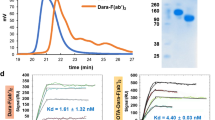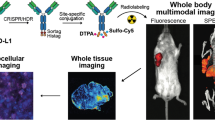Abstract
Purpose
Obinutuzumab is the first fully humanized and glycoengineered monoclonal antibody (mAb) directly targeting CD20 antigen, which is expressed on B cell lymphocytes and the majority of non-Hodgkin’s lymphoma (NHL). This study aims to design a diagnostic molecular probe, Cy7-Obinutuzumab (Cy7-Obi), in which Cy7 is a near-infrared fluorescent dye. This probe is used to noninvasively image CD20 antigen expressed in NHL cells.
Procedures
Cy7-Obi probe was synthesized through nucleophilic substitution reaction between NHS-Cy7 and obinutuzumab. After purification, the conjugate was fully characterized by a series of methods. The immunoreactivity and molecular specificity of the probe were confirmed using flow cytometry and in vitro microscopy on Raji (CD20-positive) cells. For in vivo imaging, Cy7-Obi probe (1 nmol) was injected intravenously in severe combined immunodeficiency (SCID) mice bearing Raji tumors which overexpress CD20 (n = 3) and was imaged with near-infrared fluorescence (NIRF) at 6, 9, 12, 24, 60, and 96 h post-probe injection. For pre-block, obinutuzumab (3.25 mg) was injected intravenously in tumor-bearing mice 6 h before the administration of Cy7-Obi probe.
Results
The synthesized Cy7-Obi probe in this paper mimics obinutuzumab in both structure and function. Flow cytometry analysis of the probe and obinutuzumab on Raji cells showed minor difference in binding affinity/specificity with CD20. The probe showed significant fluorescence signal when it was examined on Raji cells using in vitro microscopy. The fluorescence signal can be blocked by pretreatment with obinutuzumab. The probe Cy7-Obi also showed high tumor uptake when it was examined by in vivo optical imaging on Raji tumor-bearing mice. The tumor uptake can be blocked by pretreatment with obinutuzumab (n = 3, p < 0.05). The in vivo imaging results were also confirmed by ex vivo imaging of dissected organs. Finally, the probe Cy7-Obi has shown excellent tumor targeting and specificity through immunofluorescence analysis.
Conclusions
We have shown that humanized Cy7-Obi probe can be used for NIRF imaging successfully. The probe may be an effective and noninvasive diagnostic molecular probe capable of tracking CD20 overexpression in NHL.





Similar content being viewed by others
References
Siegel R, Naishadham D, Jemal A (2013) Cancer statistics, 2013. CA: A Cancer Journal for Clinicians 63:11–30
Alexander DD, Mink PJ, Adami HO et al (2007) The non-Hodgkin lymphomas: a review of the epidemiologic literature. Int J Cancer 120:1–39
Mohrbacher A (2005) B cell non-Hodgkin’s lymphoma: rituximab safety experience. Arthritis Res Ther 7:S19–S25
Tedder TF, Engel P (1994) CD20: a regulator of cell-cycle progression of B lymphocytes. Immunol Today 15:450–454
Polyak MJ, Li H, Shariat N, Deans JP (2008) CD20 homo-oligomers physically associate with the B cell antigen receptor. Dissociation upon receptor engagement and recruitment of phosphoproteins and calmodulin-binding proteins. J Biol Chem 283:18545–18552
Kawabata KC, Ehata S, Komuro A et al (2013) TGF-β-induced apoptosis of B-cell lymphoma Ramos cells through reduction of MS4A1/CD20. Oncogene 32:2096–2106
Einfeld DA, Brown JP, Valentine MA et al (1988) Molecular cloning of the human B cell CD20 receptor predicts a hydrophobic protein with multiple transmembrane domains. EMBO J 7:711–717
Press OW, Appelbaum F, Ledbetter JA et al (1987) Monoclonal antibody 1F5 (anti-CD20) serotherapy of human B cell lymphomas. Blood 69:584–591
Anderson KC, Bates MP, Slaughenhoupt BL et al (1984) Expression of human B cell-associated antigens on leukemias and lymphomas: a model of human B cell differentiation. Blood 63:1424–1433
Perz J, Topaly J, Fruehauf S et al (2002) Level of CD 20-expression and efficacy of rituximab treatment in patients with resistant or relapsing B-cell prolymphocytic leukemia and B-cell chronic lymphocytic leukemia. Leuk Lymphoma 43:149–151
Cheson BD, Leonard JP (2008) Monoclonal antibody therapy for B-cell non-Hodgkin’s lymphoma. N Engl J Med 359:613–626
Robak T (2009) GA-101, a third-generation, humanized and glyco-engineered anti-CD20 mAb for the treatment of B-cell lymphoid malignancies. Curr Opin Investig Drugs 10:588–596
Janice MR (2011) Antibody-based therapeutics to watch in 2011. MAbs 3:76–99
Stopar TG, Mlinaric-Rascan I, Fettich J et al (2006) 99mTc-rituximab radiolabelled by photo-activation: a new non-Hodgkin’s lymphoma imaging agent. Eur J Nucl Med Mol Imaging 33:53–59
Gmeiner ST, Fettich J, Zver S et al (2008) 99mTc-labelled rituximab, a new non-Hodgkin’s lymphoma imaging agent: first clinical experience. Nucl Med Commun 29:1059–1065
Natarajan A, Gowrishankar G, Nielsen CH et al (2012) Positron emission tomography of 64Cu-DOTA-Rituximab in a transgenic mouse model expressing human CD20 for clinical translation to image NHL. Mol Imaging Biol 14:608–616
Olafsen T, Betting D, Kenanova VE et al (2009) Recombinant anti-CD20 antibody fragments for small-animal PET imaging of B-cell lymphomas. J Nucl Med 50:1500–1508
Olafsen T, Sirk SJ, Betting DJ et al (2010) ImmunoPET imaging of B-cell lymphoma using 124I-anti-CD20 scFv dimers (diabodies). Protein Eng Des Sel 23:243–249
Biffi S, Garrovo C, Macor P et al (2008) In vivo biodistribution and lifetime analysis of cy5.5-conjugated rituximab in mice bearing lymphoid tumor xenograft using time-domain near-infrared optical imaging. Mol Imaging 7:272–282
Wu Y, Cai W, Chen X (2006) Near-infrared fluorescence imaging of tumor integrin ανβ3 expression with Cy7-labeled RGD. Mol Imaging Biol 8:226–236
Sampath L, Kwon S, Ke S et al (2007) Dual-labeled trastuzumab-based imaging agent for the detection of human epidermal growth factor receptor 2 overexpression in breast cancer. J Nucl Med 48:1501–1510
Kim TI, Park J, Park S et al (2011) Visualization of tyrosinase activity in melanoma cells by a BODIPY-based fluorescent probe. Chem Commun (Camb) 47:12640–12642
Vinegoni C, Botnaru I, Aikawa E et al (2011) Indocyanine green enables near-infrared fluorescence imaging of lipid-rich, inflamed atherosclerotic plaques. Sci Transl Med 3(84):84ra45
Jensen SA, Day ES, Ko CH et al (2013) Spherical nucleic acid nanoparticle conjugates as an RNAi-based therapy for glioblastoma. Sci Transl Med 5(209):209ra152
van der Poel HG, Buckle T, Brouwer OR et al (2011) Intraoperative laparoscopic fluorescence guidance to the sentinel lymph node in prostate cancer patients: clinical proof of concept of an integrated functional imaging approach using a multimodal tracer. Eur Urol 60:826–833
Greg TH (2008) Bioconjugate techniques. In: Greg TH (ed) Fluorescent probes. Academic, San Diego, pp 396–405
Morrison LE (2008) Basic principles of fluorescence and energy transfer. Methods Mol Biol 429:3–19
Marras SA, Kramer FR, Tyagi S (2002) Efficiencies of fluorescence resonance energy transfer and contact-mediated quenching in oligonucleotide probes. Nucleic Acids Res 30:e122
Miller JN (2005) Fluorescence energy transfer methods in bioanalysis. Analyst 130:265–270
Brun MP, Gauzy-Lazo L (2013) Protocols for lysine conjugation. Methods Mol Biol 1045:173–187
Anders JC, Parten BF, Petrie GE et al (2003) Using amino acid analysis to determine absorptivity constants: a validation case study using bovine serum albumin. Biopharm International 16:30–37
Van Meerten T, van Rijn RS, Hol S et al (2006) Complement-Induced cell death by rituximab depends on CD20 expression level and acts complementary to antibody-dependent cellular cytotoxicity. Clin Cancer Res 12:4027–4035
Wu L, Wang C, Zhang D et al (2010) Characterization of a humanized anti-CD20 antibody with potent antitumor activity against B-cell lymphoma. Cancer Lett 292:208–214
Aoki V, Sousa JX Jr, Fukumori LM et al (2010) Direct and indirect immunofluorescence. An Bras Dermatol 85:490–500
Lin X, Zhu H, Hong Y et al (2013) Synthesis and evaluation of Cy7-Rituximab targeting CD20 antigen for in vivo animal fluorescence imaging. Chem J Chinese U 34:2139–2145
Natarajan A, Habte F, Liu H et al (2013) Evaluation of 89Zr-rituximab tracer by Cerenkov luminescence imaging and correlation with PET in a humanized transgenic mouse model to image NHL. Mol Imaging Biol 15:468–475
Tang B, Cui L, Xu K et al (2008) A sensitive and selective near-infrared fluorescent probe for mercuric ions and its biological imaging applications. Chembiochem 9:1159–1164
Zhang Y, Hong H, Engle JW et al (2012) Positron emission tomography and near-infrared fluorescence imaging of vascular endothelial growth factor with dual-labeled bevacizumab. Am J Nucl Med Mol Imaging 2:1–13
Dixit R, Boelsterli UA (2007) Healthy animals and animal models of human disease(s) in safety assessment of human pharmaceuticals, including therapeutic antibodies. Drug Discov Today 12:336–342
Mashimo T, Takizawa A, Kobayashi J et al (2012) Generation and characterization of severe combined immunodeficiency rats. Cell Rep 2:685–694
Ghirardelli ML, Jemos V, Gobbi PG (1999) Diagnostic approach to lymph node enlargement. Haematologica 84:242–247
Acknowledgments
We thank the staff in Central Laboratory and Laboratory Animal Unit at Peking University Cancer Hospital & Institute and Dr. Xiaolong Liang in the Department of Biomedical Engineering at the College of Engineering in Peking University for instrumentation support and analysis. This work was supported by the National Natural Science Foundation of China (No. 81071198, No. 81172083, No. 81371592), Beijing Natural Science Foundation (No. 7132040), and Peking University Cancer Hospital& Institute Research Foundation (2013 ZiZhu 12).
Conflict of Interest
The authors declare that they have no conflicts of interest.
Author information
Authors and Affiliations
Corresponding author
Additional information
Xinfeng Lin and Hua Zhu contributed equally to this study.
Electronic supplementary material
Below is the link to the electronic supplementary material.
ESM 1
(DOCX 240 kb)
Rights and permissions
About this article
Cite this article
Lin, X., Zhu, H., Luo, Z. et al. Near-Infrared Fluorescence Imaging of Non-Hodgkin’s Lymphoma CD20 Expression Using Cy7-Conjugated Obinutuzumab. Mol Imaging Biol 16, 877–887 (2014). https://doi.org/10.1007/s11307-014-0742-3
Published:
Issue Date:
DOI: https://doi.org/10.1007/s11307-014-0742-3




